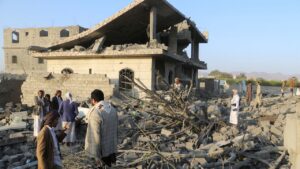
The United States conducted extensive airstrikes against Iran-backed Houthi rebels in Yemen, resulting in at least 31 fatalities and over 100 injuries, including civilians, according to Houthi-run media. These operations aim to deter the Houthis from targeting military and commercial vessels in the Red Sea, a vital international shipping corridor.
The airstrikes targeted multiple locations, including the capital city, Sanaa, and the strategic port city of Hodeidah. The U.S. Department of Defense stated that these actions are part of a broader strategy to degrade the Houthis’ capacity to disrupt maritime navigation and to send a clear message regarding the protection of international trade routes.
In response, Houthi leader Abdul-Malik al-Houthi warned of potential retaliatory measures against U.S. military assets, indicating a readiness to escalate operations if the airstrikes persist. He emphasized the group’s capability to target American interests in the region, raising concerns about a potential intensification of the conflict.
The United Nations has expressed alarm over the escalating violence, with Secretary-General António Guterres urging all parties to exercise restraint and prioritize dialogue. The U.N. highlighted the severe humanitarian crisis in Yemen, cautioning that further military actions could exacerbate the already dire situation for civilians.
Iran, accused by the U.S. of supplying military support to the Houthis, has denied involvement, labeling the airstrikes as violations of international law and Yemen’s sovereignty. The Iranian government warned of serious repercussions if the attacks continue, further complicating the geopolitical landscape in the Middle East.
This development marks one of the most significant U.S. military operations against the Houthis in recent years, reflecting heightened efforts to secure maritime routes and counter perceived Iranian influence in the region. The situation remains fluid, with the international community closely monitoring for potential escalations.




